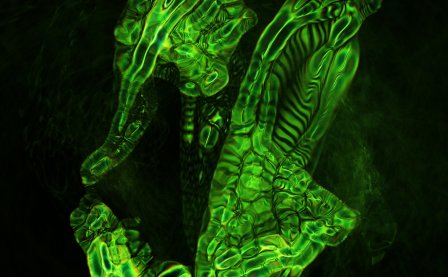Reading through all the different uses of the phrase “in situ” on Wikipedia kind of feels like going over a laundry list of inspirations for a new Laurel Halo record. The phrase means “on site” and is a widely-adopted piece of jargon for a number of different fields of study (aerospace, electrochemistry, petroleum production, environmental cleanup, vacuum technology, gastronomy), but it most commonly refers to when tests or measurements are taken in the original space a phenomenon occurred in. Most of the time, the purpose of in situ experimentation is to understand how something works in its original system without outside alteration. Fittingly, Laurel Halo’s latest double EP In Situ is a record of beats scarcely modified and bizarre melodies in stasis.
In Situ is a modest record, a shy success. It sets up its scenarios and knocks them down appropriately, working within the confines of strict compositional parameters to shift an offbeat chemical reaction back and forth between interesting modes. The emphasis here is on inherent processes; Laurel is creating these pieces under very strict parameters, seemingly confined to the material allowed by a certain drum machine, a semi-locked loop with limited filters, and little to no external production. Each work is composed of two layers: an undercurrent of static rhythm (the “situation”) and a selection of curios to vamp over it — tones, whistles, squeals, oddly percussed sheet metal, and other techno detritus. Each piece unfolds in a predictably unpredictable way: the beats don’t align with any specific genre moments, so they’re nebulously “IDM-y,” but the timing is solid enough and the songs bare enough that nothing collapses into mindless density. Everything lies on the surface as observable phenomena. Each piece can be picked up, scrutinized, consumed, a little morsel of flavor.
First listen might suggest that In Situ’s a record always on the verge of collapse, a vague splay of dry samples, but it’s actually tied down pretty conventionally, often by the first few notes you hear. Take “Leaves,” for example: a shimmering pair of cymbals provide simplistic momentum to confused, disfigured patterns of snare and kick that sputter out in un-quantized clusters. The whole quivering thing stands on a plane that’s barely perceptible, a faint lilting loop, slick and oily, but internally consistent by way of its “situation.” “Nah” is the same way, establishing a staid rhythm that provokes accompaniment and answering with indiscriminately swung offbeats. Only on “Shake” and “Nimrud” is the core groove dropped or significantly altered, the former cutting a drum roll into shapeless pieces of waiting-room techno and the latter a syrupy shake of low and hi passes. “Focus I” is the record’s best proof of concept, mixing a loop of ceaselessly sloshing white noise with electric piano reminiscent of previous album, Chance Of Rain.
It would be tempting to say that In Situ suffers from a lack of Laurel Halo’s voice, because her voice is part of what made Quarantine such a stunning high-water mark, but Chance Of Rain didn’t suffer for the same reason, and I actually don’t know that this record would benefit from it. Chance Of Rain was a smaller record than Quarantine in scope, but the record still breathed with energy and emotion, reflected through its ingenious melodic choices and cerebral shifts in tone. In Situ, in comparison, just seems like a bit of lethargic techno, an
More about: Laurel Halo




